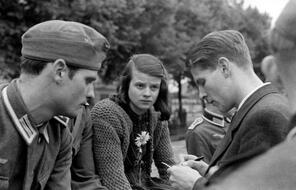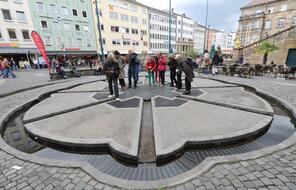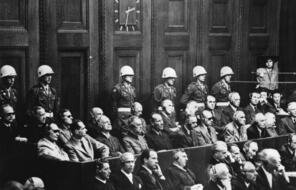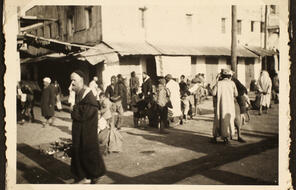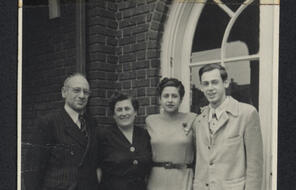The Technology of Mass Murder
At a Glance
Language
English — USSubject
- History
- Social Studies
- Human & Civil Rights
- The Holocaust
In 1945, Germany’s boundaries were redrawn, and the country was divided into four “zones of occupation.” Each zone was governed by one of the Allied powers: the United States, Britain, France, and the Soviet Union. After the first trial at Nuremberg, each Allied power continued holding trials for former Nazis and their collaborators in their own zones of occupation.
Doctors who had carried out medical experiments on concentration camp inmates, as well as engineers and technicians who helped to create the technology of mass death, were among those tried by the Allies. Leo Alexander, a psychiatrist who was a consultant to the Office of the Chief Counsel for War Crimes in Nuremberg, summarized his findings about Nazi medical research:
A large part of [German] research was devoted to the science of destroying and preventing life. . . . In the course of this . . . research, methods of mass killing and mass sterilization were investigated and developed for use against non-German peoples or Germans who were considered useless.
. . . A rapid method developed for sterilization of females, which could be accomplished in the course of a regular health examination, was the intra-uterine injection of various chemicals. . . . The injections were extremely painful, and a number of women died in the course of the experiments. Professor Karl Clauberg reported that he had developed a method at the Auschwitz concentration camp by which he could sterilize 1,000 women in a day. . . .
The development of methods for rapid and inconspicuous individual execution was the objective of another large part of . . . research. . . . Poisons were the subject of many of these experiments. A research team at the Buchenwald concentration camp, consisting of Drs. Joachim Mrugowsky, Erwin Ding-Schuler and Waldemar Hoven, developed one of the most widely used means of individual execution under the guise of medication treatment—namely, the intravenous injection of phenol [a toxic chemical] or gasoline. 1
Engineers worked to develop the technology for mass death. When the Soviets entered Auschwitz-Birkenau, they found records that detailed the construction of the crematoria, including precise information about costs as well as calculations of how many corpses each furnace could incinerate in a single day. The Russians captured four of the engineers who had designed and built the furnaces for a company called Topf and Sons and interrogated all four men. The interrogation of Kurt Prüfer, one of the four, included the following exchange:
Q. How often and with what aim did you visit Auschwitz?
A. Five times. The first time [was] at the beginning of 1943, to receive the orders of the SS Command, where the “Kremas” were to be built. The second time was in spring 1943 to inspect the building site. The third time was in autumn 1943 to inspect a fault in the construction of a “Krema” chimney. The fourth time [was] at the beginning of 1944 to inspect the repaired chimney. The fifth time [was] in September-October 1944 when I visited Auschwitz in connection with the intended relocation [from Auschwitz] of the crematoria, since the front was getting nearer. The crematoria were not relocated, because there were not enough workers. . . .
Q. Did you see a gas chamber next to the crematorium?
A. Yes, I did see one next to the crematorium. Between the gas chamber and the crematorium there was a connecting structure.
Q. Did you know that in the gas chambers and the crematoria there took place the liquidations of innocent human beings?
A. I have known since spring 1943 that innocent human beings were being liquidated in Auschwitz gas chambers and that their corpses were subsequently incinerated in the crematoria. . . .
Q. Why was the brick lining of the muffles so quickly damaged?
A. The bricks were damaged after six months because the strain on the furnaces was colossal.
Q. What motivated you to continue with the building of the other crematoria as senior engineer with Topf?
A. I had my contract with the Topf firm and I was aware of the fact that my work was of great importance for the national socialist state. I knew that if I refused to continue with this work, I would be liquidated by the Gestapo. 2
The Russians also questioned Fritz Sander about the crematoria. He expressed concern about the strain on the furnaces.
I decided to design and build a crematorium with a higher capacity. I completed this project . . . and I submitted [it] to a State Patent Commission in Berlin.
The “Krema” was to be built on the conveyor belt principle. That is to say, the corpses must be brought to the incineration furnaces without interruption. When the corpses are pushed into the furnaces, they fall onto a grate, then slide into the furnace and are incinerated. The corpses serve at the same time as fuel for the heating of the furnaces. . . .
Q. Although you knew about the mass liquidation of innocent human beings in crematoria, you devoted yourself to designing and creating higher capacity incineration furnaces for crematoria—and on your own initiative.
A. I was a German engineer and key member of the Topf works and I saw it as my duty to apply my specialist knowledge in this way in order to help Germany win the war, just as an aircraft construction engineer builds airplanes in wartime, which are also connected with the destruction of human beings. [Sander’s design was never carried out.] 3
Sander died of a heart attack a few weeks after his interrogation. The Soviet Union sentenced Prüfer to 25 years in prison for “crimes against the civilian population and captive members of the Red Army.” He died of a stroke in 1952. The other two engineers captured by the Soviets, Gustav Braun and Karl Schultze, were also sentenced to 25 years in prison, but they were released in 1955. 4
Connection Questions
- What roles did science, medicine, and engineering play in the mass murder perpetrated by the Nazis?
- The trial of Nazi doctors at Nuremberg led to the creation of ethical guidelines for medical experiments conducted on humans. Known as the “Nuremberg Code,” these guidelines established the principle of “informed consent,” which means that researchers may not perform experiments on human subjects without their voluntary consent. Today, most physicians take a professional oath to follow certain ethical guidelines when they care for their patients. Do workers in other roles, such as engineers, have ethical obligations that are specific to their profession?
- How did the engineers Prüfer and Sander perceive their task? Did they know the purpose of the crematoria they designed and helped build? What motivated them to do this work? To what extent were they responsible for the deaths of prisoners at Auschwitz?
- Prüfer claimed that he would be “liquidated” by the Gestapo if he refused to “continue with this work.” Today, scholars point out that there is no evidence of any German having been executed for refusing to participate in the murder of Jews. Does Prüfer’s belief that he would face death, even if mistaken, diminish his moral responsibility?
- Sander said it was “my duty to apply my specialist knowledge in this way in order to help Germany win the war, just as an aircraft construction engineer builds airplanes in wartime, which are also connected with the destruction of human beings.” Is there an ethical difference between constructing weapons for a military to use to kill soldiers and creating technology for the murder of civilians during wartime? To what extent are designers and engineers responsible for the tools and weapons they create and the ways in which those tools and weapons are used?
- 1Leo Alexander, “Medical Science Under Dictatorship,” New England Journal of Medicine 241, no. 2 (July 14, 1949): 41.
- 2Gerald Fleming, “Engineers of Death,” New York Times, July 18, 1993.
- 3Gerald Fleming, “Engineers of Death,” New York Times, July 18, 1993.
- 4“Topf & Sons - Builders of the Auschwitz Ovens,” Topf & Sons Builders of the Auschwitz Ovens Place of Remembrance, accessed July 12, 2016.
How to Cite This Reading
Facing History & Ourselves, "The Technology of Mass Murder," last updated August 2, 2016.



